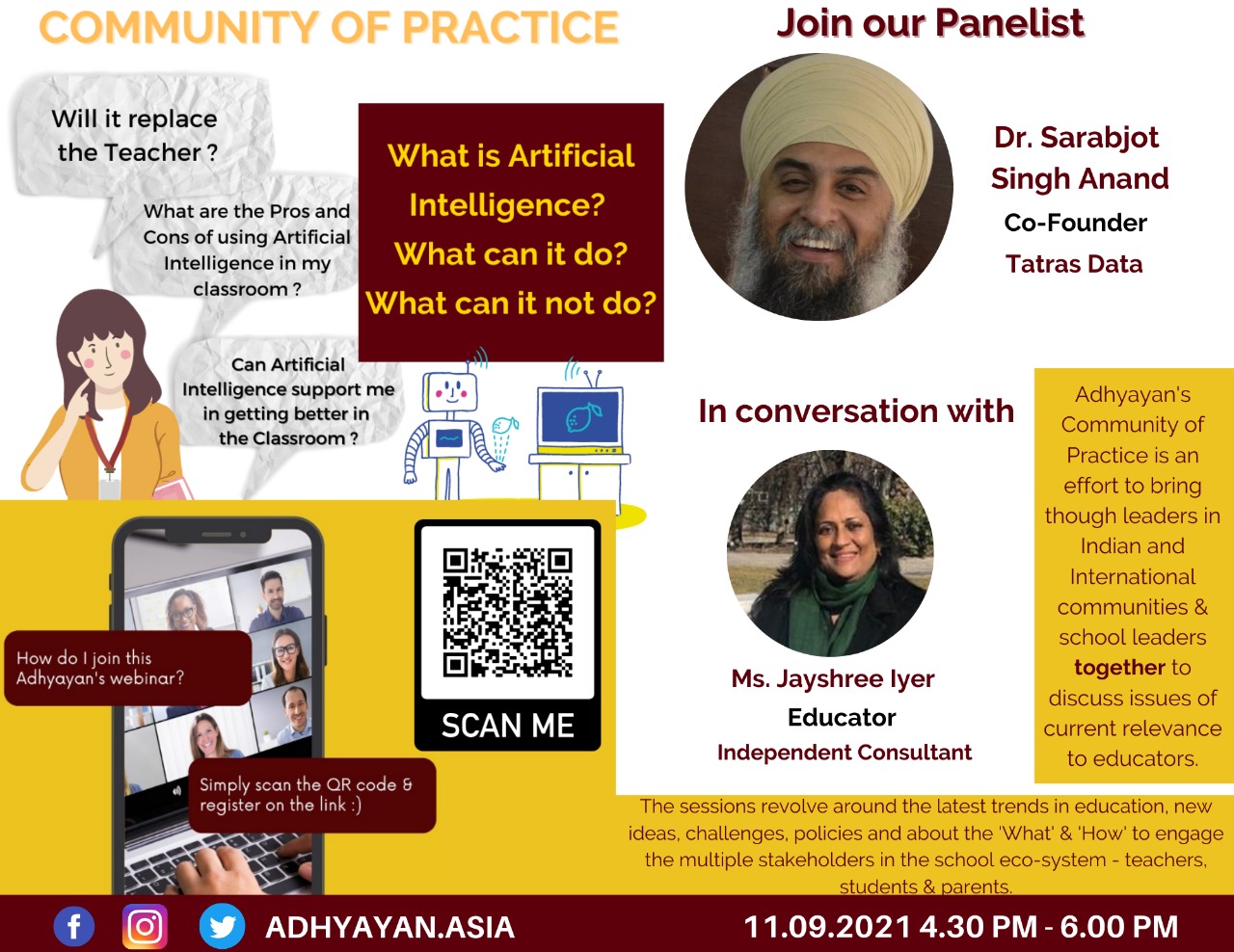What is Artificial Intelligence? What can it do? What can it not do?
 The Adhyayan’s Community of Practice organized a webinar on the 11th of September, 2021 on a rather interesting topic: Artificial Intelligence.
The Adhyayan’s Community of Practice organized a webinar on the 11th of September, 2021 on a rather interesting topic: Artificial Intelligence.
The session began with the speaker Ms. Jayshree Iyer introducing the panelist Dr. Sarabjot Singh Anand. During the course of the introduction, Jayshree put forth a quite simple yet thoughtful question forward to all the attendees – What comes to your mind when you hear the term Artificial Intelligence? The most frequent answers were: robotics or robots, automatic, ethics, not human intelligence, and anything you understand beyond your limits. Jayshree then proceeded to give a few examples of our day to day life where AI is actually used. This included bank payments, virtual assistants like Alexa and Siri, and also our very own Aarogya Setu app, wherein we also see that approximate cases which might hit us are also predicted based on current data. Since schools have reopened in some places and are in the process of reopening, the authorities have asked the schools to integrate AI into their curriculum. With respect to this another question was put forth to the participants: What queries do you have regarding AI? Some of the replies were – In what areas does it replace humans, How can AI be used in a socially equitable way to strengthen learning for all; Does everyone in the coming generation need to learn coding and AI? Pertinent questions were put forth by the participants.
The stage was handed over to Dr. Sarabjot Singh Anand to explain all the nuances of Artificial Intelligence. He began by giving a brief history as to how AI was introduced into the world and how, after the world wars, the thought of using machines for something other than destruction was born. The mathematician Alan Turing was a trail blazer in this field as he was one of the persons who thought of using the probability theory and inculcating that into understanding and creating AI. Turing also said that the human brain is very much like a digital computer. Dr. Sarabjot went ahead and said that it is a very exciting time to be alive in a digital era; the reason why AI is very popular now is that there is so much digital data available. He drew parallels between a child and AI, in the sense that the way a child learns and understands new things through his senses, AI is a learning curve which keeps on soaking in information and data.
A question was posed as to how Artificial Intelligence can be used in teaching. Dr. Sarabjot said that while everyone knows that a domain model has to be set for the concepts, another model has to be created for the learner as well. So an assessment has to be carried out as to what that particular student is grasping. This is because every learner will understand a thing differently. He also mentioned that although some people think that teaching will be completely digitalised and taken over by AI, in the sense that teachers won’t be needed in the learning process, the fact is that the teachers are the ones who will direct and use the AI towards the betterment of the learner. The AI itself tends to be biased due to the fact that the people who have created or are creating the AI model are not the ones who will be using it; it’s the children who will be the recipients. The biggest risk for us as a nation in this field today is that we are not creating and stacking enough data. What this does is that we are relying heavily on the western world to provide us with that data. This is the reason why most of the times for any of our searches on data for any survey, we will find that the data is usually from the West.
The bottom line is that AI needs training. This is why AI is termed as a child. Just like a child, AI too will learn what we teach it. The education sector has a huge scope for the use of AI; we just need to understand that AI is our friend, not foe. It is not here to take away our jobs or replace us. Artificial Intelligence like it’s namesake is intelligence, and intelligence needs to be updated with the times, otherwise it is not intelligence anymore. Hence, AI can do a lot of things, but it also has many limitations as well. It can try to think like a human mind, but we all know that the mind is too complex to replicate completely. The mind uses causation, while AI uses correlation. This is where Artificial Intelligence is limited at the moment. In course of time, it will only get better and more refined.
The session was a thoroughly insightful one with tons of references to daily life. Artificial Intelligence is here to stay, and it will be an integral part of the future.
 – Written by Mrs. Namrata Cheke, Teacher at Don Bosco High School, Matunga
– Written by Mrs. Namrata Cheke, Teacher at Don Bosco High School, Matunga
Click here to watch the full session